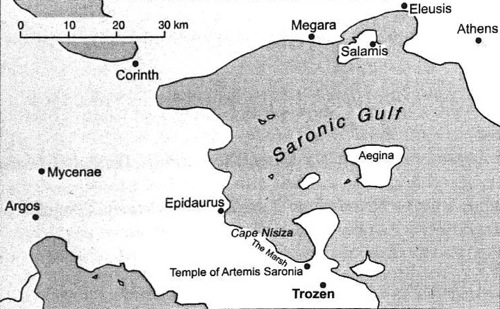Sanctuary of Asclepius, Troizen
Archaeological Development
Thucydides (II.56) tells us that the city was sacked by Athens in the Peloponnesian Wars.
The city of Troizen was the subject of a major archaeological study from 1892 to 1907 by French archaeologist Philippe Legrand. Legrand produced a map of the city and the temple of Hippolytus, containing the Asklepieion. However his excavations of the temple were incomplete and a more detailed study was carried out by Gabriel Welter in the 1930's. Welter wrote a detailed archaeological study of the site and it's surviving structures. Welter was especially concerned with the precise location of the sanctuary and it's relationship with the temple to Hippolytus situated to the South.
Welter dates the construction of the temple to the 4th Century BC, believing it to be completed in the 3rd Century. He also theorises that the Asklepieion absorbed a smaller temple dedicated to the hero Hippolytus, who was the subject of hero worship, or possibly deification, in Troizen.
Gods/Heroes
A temple to the healing god Asclepius, and a site of healing of the sick or injured living around the sanctuary. Asclepius' origin is debateable with some believing him to be the subject of hero worship who became a god, and others believing him to be wholly divine. The popularity of the cult of Asclepius as healer grew massively in the 5th and 4th Centuries, when the sanctuary at Troizen was built.
Ritual Activity
Dedications -
In the area around Troizen a large statue of Asclepius by Timotheos is described by Thucydides. However the citizens of Troizen claim this is a statue of the hero Hippolytus and not Asclepius, so it's origins are unknown.
Healing and Surgery -
There is a stele which tells the story of a woman who had a worm and came to the sanctuary to be healed. In a vision during her sleep she saw that the god was away so the attendants cut off her head in an attempt to remove the worm. In a vision the following night she saw Asclepius return from Epidaurus, where he had been the previous night, reattach her head, and remove the worm. She left the sanctuary healed and so set up the stele. However, this story is also told by Hippys about Epidaurus, so it is unclear which sanctuary was the true location of the miracle. (IG IV 122 XXIII)
A similar story tells of a woman who suffered a false pregnancy, and was in fact pregnant with a worm. She went to Epidaurus and slept there, but had no dream and left. On the way home a beautiful man appeared to her, cut her open and took out the worms. She then went to sleep in the temple at Troizen, and the sons of the god- who was too busy to come himself - cut off her head, plunged their hands into her intestines, and pulled out the worm.
Another (IG IV 123 XLVIII) tells the story of a man who came for suppuration. The doctors at Troizen prepared for surgery but the god told the man he would be cauterized then sleep in the temple at Epidaurus. The rest of this story is, unfortunately, lost but stands as evidence of possible rational medical practice at Troizen and a link between the two sanctuaries. Rational surgery was not practiced widely at Epidaurus so the two sanctuaries could in fact stand apart; at Troizen, medicine was practiced, at Epidaurus, miracles.
Historical Significance
This site is one of many built during the growth of interest in the cult of Asclepius in the 5th and 4th Century. The stories of it's instances of healing are important as they describe how the god could not heal at both Epidaurus and Troizen simultaneously, with one patient having to wait until he was free to be seen. This stipulation however fell out of use over time and Asclepius became able to heal at multiple sites at once. This site therefore offers some insight into the development of the cult over time.
Who used the site, and where did they come from?
Due to the site's proximity to the much larger and more famous Epidaurus, it was likely frequented mostly by citizens of Troizen and the surrounding rural areas. All references to treatments we have are of citizens of Troizen.
Select Site Bibliography
Walton, A (1979) Asklepios: The Cult of the Greek God of Medicine
Welter, G. (1941) Troizen and Kalaureia (trans. Linda Atkinson 2012)
Wickkiser, B.L. (2008) Asklepios, Medicine, and the Politics of Healing in Fifth-Century Greece
http://www.troizenarchaeology.com/
http://www.classictheatre.com/
Footnotes
1- To enter footnotes, put [1] in your text above, and place the footnote down here.
2- If you press "shift + enter" it will insert a line break without any paragraph spacing.
Location
The sanctuary is located about 1 kilometre West of the city of Troizen, in the Northeastern Peloponnese.

Map showing Troizen and it's proximity to Epidaurus in the Peloponnese

Ruins at the site of the temple.
